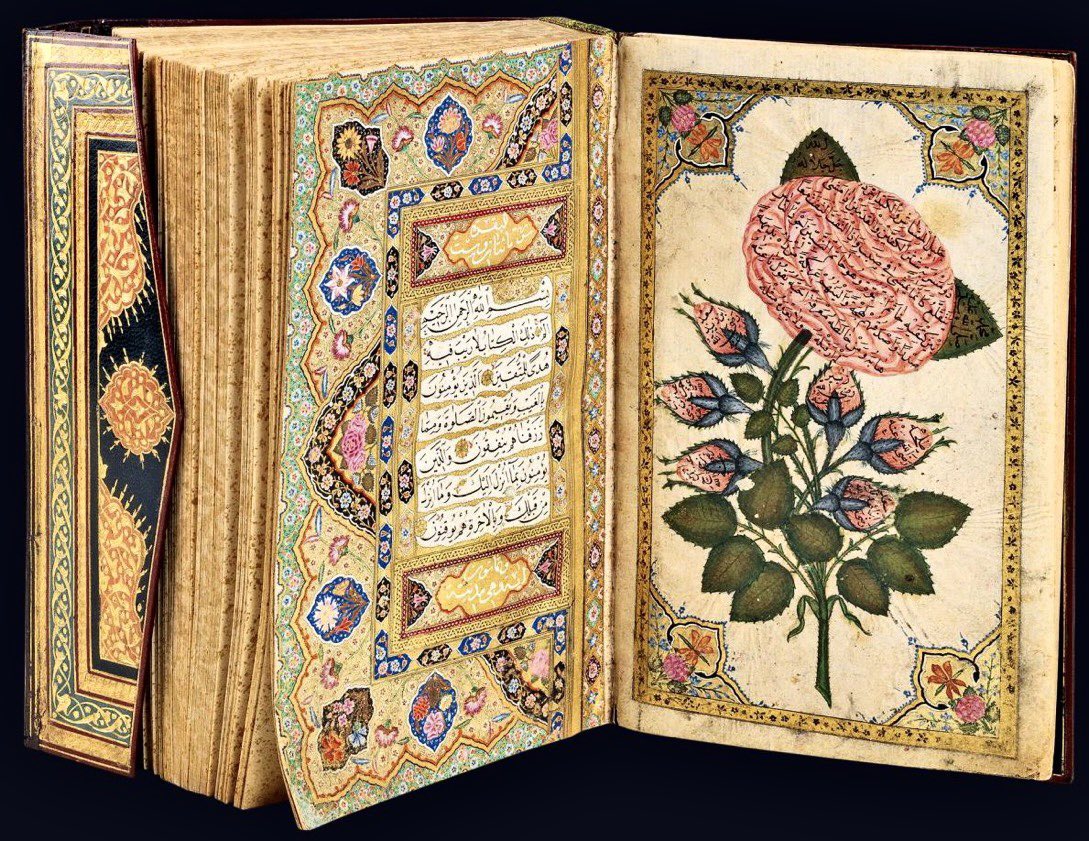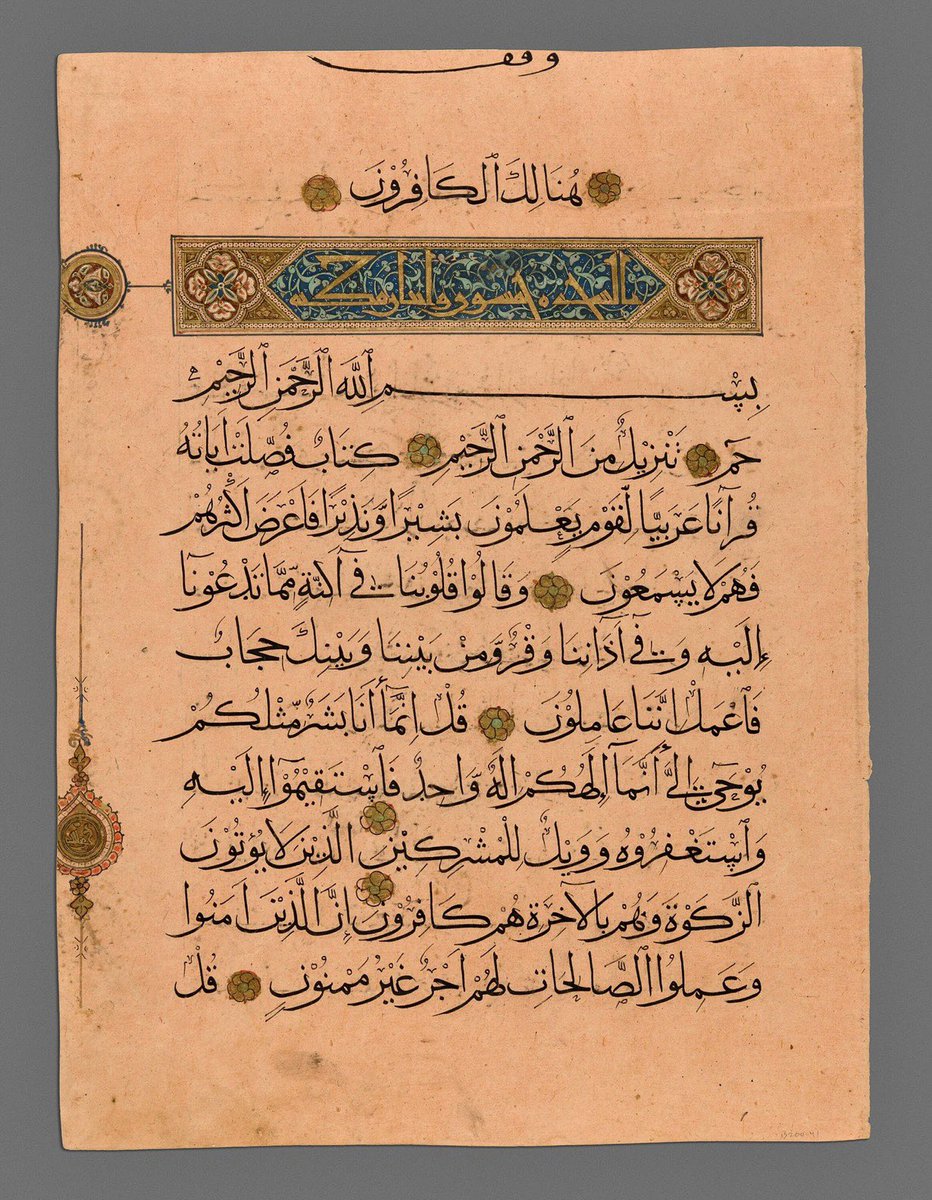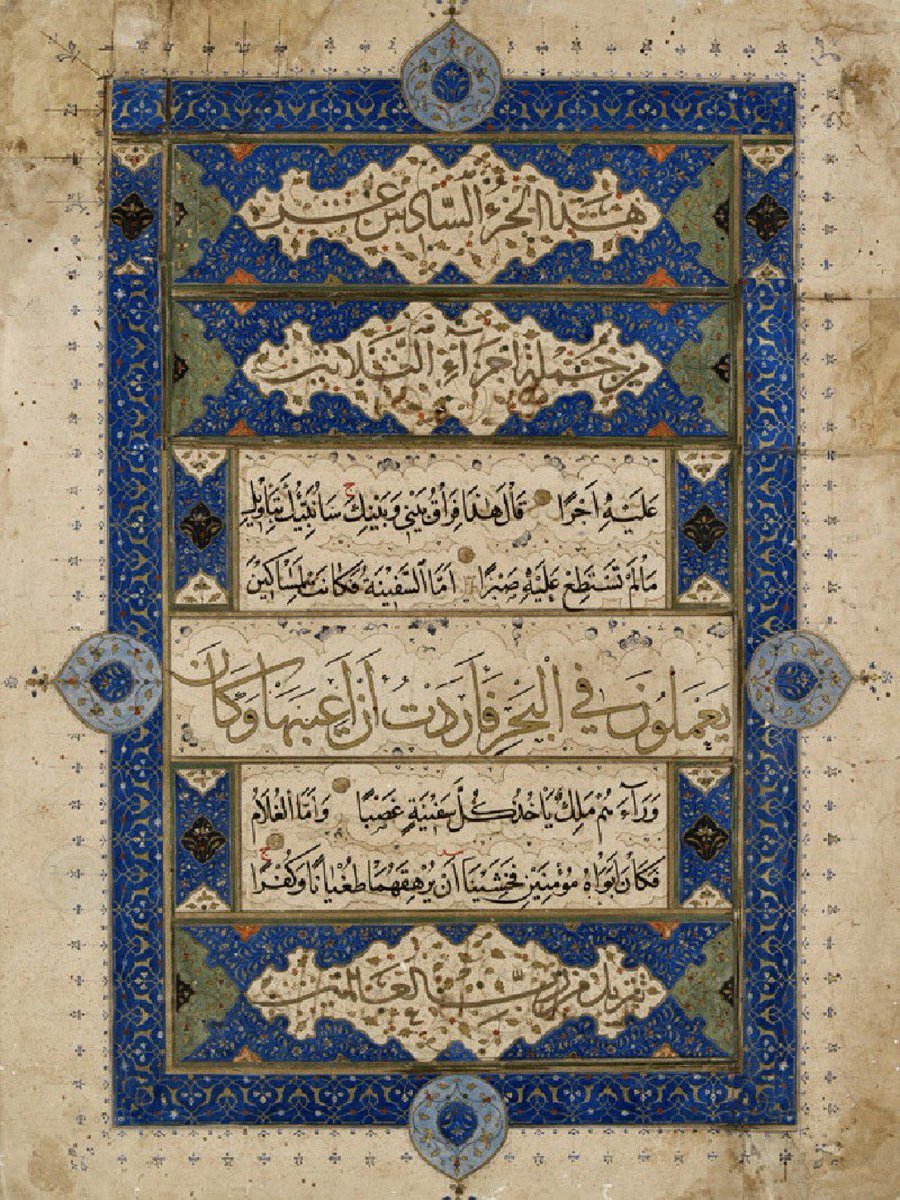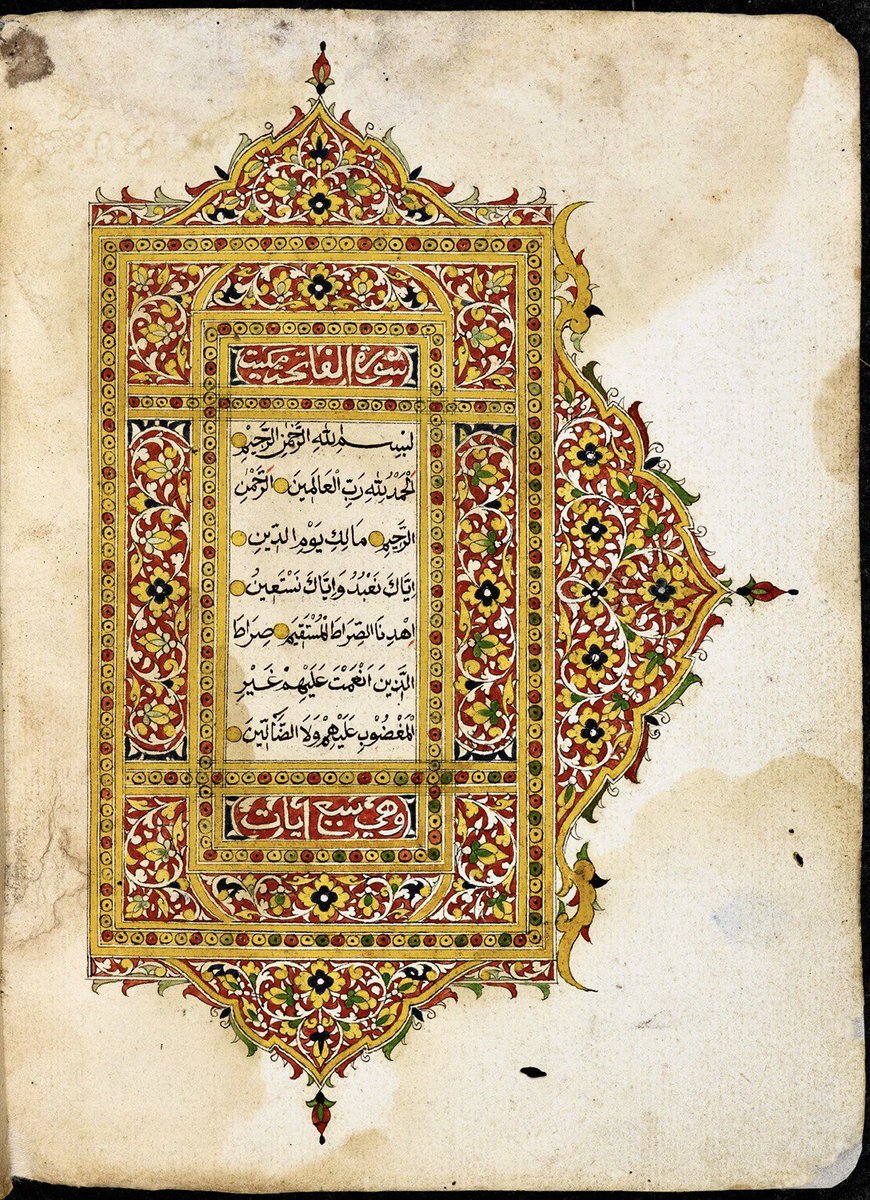The very foundation of Islam is literacy - to read & seek knowledge. The first word of the Qur’an revealed to Prophet Muhammad (PBUH) was “Iqra” which means Read.
To celebrate International Literacy Day, here are 24 beautiful Qur’anic manuscripts in museums across the world…
To celebrate International Literacy Day, here are 24 beautiful Qur’anic manuscripts in museums across the world…

1/ ‘Read: In the name of thy Lord who created. Created man from a leech like clot. Read: And your Lord is the Most Bountiful. He taught by the pen. He taught man which he knew not’ (Al-`Alaq 96:1-5)
Folio, Manuscript of the Qur'an
Iran, 1550-1575
@LACMA #InternationalLiteracyDay
Folio, Manuscript of the Qur'an
Iran, 1550-1575
@LACMA #InternationalLiteracyDay

2/ In Islam, the duty of seeking knowledge & learning is obligatory for every Muslim. Islam affirms the right to education for all, without discrimination.
Qur’an leaf in Muhaqqaq script
Mamluk period, c. A.H. 728 / A.D. 1327
Egypt
@artinstitutechi #InternationalLiteracyDay
Qur’an leaf in Muhaqqaq script
Mamluk period, c. A.H. 728 / A.D. 1327
Egypt
@artinstitutechi #InternationalLiteracyDay

3/ Calligraphers who specialized in beautiful writing often dedicated their lives to copying the Qur’an to grow closer to Allah and receive his blessings.
Qur'an Manuscript Folio,
Afghanistan, Herat, Safavid period (1501–1722)
@ClevelandArt #InternationalLiteracyDay
Qur'an Manuscript Folio,
Afghanistan, Herat, Safavid period (1501–1722)
@ClevelandArt #InternationalLiteracyDay

4/ Double Folio from a Qur'an
c. 1330-1350, Central Asian or Turkish
Early Muslim settlers from central & western Asia carried Islamic book traditions to India, especially in the form of Qur'ans, such as the one from which these pages come
@philamuseum #InternationalLiteracyDay
c. 1330-1350, Central Asian or Turkish
Early Muslim settlers from central & western Asia carried Islamic book traditions to India, especially in the form of Qur'ans, such as the one from which these pages come
@philamuseum #InternationalLiteracyDay

5/ Closing Prayer in the Jerrāḥ Pasha Qur˒an
Iran, Shiraz
ca. 1580
1st of 2 pairs of ornamental facing pages that appear at the end of the Jerrāḥ Pasha Qur˒an, made in Shiraz about 1580. It enshrines a prayer written in 12 lines
@MorganLibrary #InternationalLiteracyDay
Iran, Shiraz
ca. 1580
1st of 2 pairs of ornamental facing pages that appear at the end of the Jerrāḥ Pasha Qur˒an, made in Shiraz about 1580. It enshrines a prayer written in 12 lines
@MorganLibrary #InternationalLiteracyDay

6/ Qur'an Manuscript, 18th–early 19th century
India, Kashmir
Illumination found at the opening to 9 of the suras of this Qur'an (al-Fatiha, al-Ma'ida, Yunus, Bani Isra'il, al-Shu'ara, Qaf, al- Falaq & al-Nas) style characteristic of Kashmir
@metmuseum #InternationalLiteracyDay
India, Kashmir
Illumination found at the opening to 9 of the suras of this Qur'an (al-Fatiha, al-Ma'ida, Yunus, Bani Isra'il, al-Shu'ara, Qaf, al- Falaq & al-Nas) style characteristic of Kashmir
@metmuseum #InternationalLiteracyDay

7/ Qur'an, 15th century, India
Made for a Muslim ruler in or near Delhi, this copy is one of the oldest surviving Qur’ans from India. The scribe used a distinctive script called Bihari with letters ending in long, swooping lines
@philamuseum #InternationalLiteracyDay
Made for a Muslim ruler in or near Delhi, this copy is one of the oldest surviving Qur’ans from India. The scribe used a distinctive script called Bihari with letters ending in long, swooping lines
@philamuseum #InternationalLiteracyDay

8/ This exuberant folio (Qur’an, 18:77-80) marked the beginning of the 16th part of a 30-part Qur’an
Although heavily repaired, the page exemplifies the vibrancy of book illumination in Iran during the second half of the 15th century.
@AshmoleanMuseum #InternationalLiteracyDay
Although heavily repaired, the page exemplifies the vibrancy of book illumination in Iran during the second half of the 15th century.
@AshmoleanMuseum #InternationalLiteracyDay

9/ Leaf from a Koran, mounted, illuminated in gold and colours, in Arabic. Mamluk, Egypt
@V_and_A #InternationalLiteracyDay
@V_and_A #InternationalLiteracyDay

10/ Qur’an, Safavid period, 1598 (1006 A.H.)
Calligrapher: Ahmad Sayri. Qur’an with selection of prayers and a falname; Arabic in black naskh script with white headings in illuminated cartouches in thuluth, muhaqqaq, and nasta’liq script
@NatAsianArt #InternationalLiteracyDay
Calligrapher: Ahmad Sayri. Qur’an with selection of prayers and a falname; Arabic in black naskh script with white headings in illuminated cartouches in thuluth, muhaqqaq, and nasta’liq script
@NatAsianArt #InternationalLiteracyDay

11/ Leaf from a Qur'an, 1100s
Seljuk, Iran
Opaque watercolor, ink, and gold on paper
This Qur'an page is considered one of the most splendid examples of Arabic calligraphy.
@ClevelandArt #InternationalLiteracyDay
Seljuk, Iran
Opaque watercolor, ink, and gold on paper
This Qur'an page is considered one of the most splendid examples of Arabic calligraphy.
@ClevelandArt #InternationalLiteracyDay

12/ Bifolium from the Pink Qur’an
13th century
Produced for a noble patron from either Granada or Valencia, this 13th century Spanish manuscript of the Qur’an, is known as the Pink Qur’an, due to its distinctive tinted paper
@GettyMuseum #InternationalLiteracyDay
13th century
Produced for a noble patron from either Granada or Valencia, this 13th century Spanish manuscript of the Qur’an, is known as the Pink Qur’an, due to its distinctive tinted paper
@GettyMuseum #InternationalLiteracyDay

13/ Leaf from Qur'an, Iranian
Verses of chapter 1 (Surat al-fatihah) written in Naskh script in black ink with reading marks in red & interlinear gold decoration. Chapter headings & verses are written in Riqa" script in red ink
@walters_museum #InternationalLiteracyDay
Verses of chapter 1 (Surat al-fatihah) written in Naskh script in black ink with reading marks in red & interlinear gold decoration. Chapter headings & verses are written in Riqa" script in red ink
@walters_museum #InternationalLiteracyDay

14/ This exquisite illuminated Qur’an manuscript probably comes from the northeast coast of the Malay peninsula, either from Kelantan in present-day Malaysia, or from Patani in southern Thailand.
@britishlibrary #InternationalLiteracyDay
@britishlibrary #InternationalLiteracyDay

15/ Single-volume Qur’an
This Qur’an was copied in Shiraz, by Muhammad Shafi‘, the most accomplished Persian calligrapher of the 19th century. It is the largest 19th-century Persian Qur’an known.
@KhaliliOnline #InternationalLiteracyDay
This Qur’an was copied in Shiraz, by Muhammad Shafi‘, the most accomplished Persian calligrapher of the 19th century. It is the largest 19th-century Persian Qur’an known.
@KhaliliOnline #InternationalLiteracyDay

16/ Quran Manuscript, Dagestan 19th c.
Dagestan is a republic located in the Russian Federation, & home to a rich manuscript culture. A feature of Daghistani manuscript illumination is the vibrant palette of colours.
@britishlibrary #InternationalLiteracyDay
Dagestan is a republic located in the Russian Federation, & home to a rich manuscript culture. A feature of Daghistani manuscript illumination is the vibrant palette of colours.
@britishlibrary #InternationalLiteracyDay

18/ This 17th-century Chinese Qur’an shows how Islamic styles of calligraphy and illumination were combined with local styles, symbols and aesthetics that came from a very different culture.
@britishlibrary #InternationalLiteracyDay
@britishlibrary #InternationalLiteracyDay

19/ Right-Hand Page from the Qur’an
Safavid dynasty (1501–1722)، 16th century
Iran
@artinstitutechi #InternationalLiteracyDay
Safavid dynasty (1501–1722)، 16th century
Iran
@artinstitutechi #InternationalLiteracyDay

20/ Quran Manuscript, India, 11 July 1399
Rare copy of the Qur’an produced during Tughluq dynasty (1320–1413) India. After the invasion of Timur in 1398–1399, it was taken to Gwalior Fort in Agra, where its colophon was completed
@AgaKhanMuseum #InternationalLiteracyDay
Rare copy of the Qur’an produced during Tughluq dynasty (1320–1413) India. After the invasion of Timur in 1398–1399, it was taken to Gwalior Fort in Agra, where its colophon was completed
@AgaKhanMuseum #InternationalLiteracyDay

21/ The Holy Qur’an, written in Konstantiniyye (Istanbul)
1157/1744-45
Paper with ahar & zerefsan, black ink, colored paints, gold
A leaf with a rose painted recto with prayers & verso separate the opening page image @CellardEleonore
@SSabanciMuze #InternationalLiteracyDay
1157/1744-45
Paper with ahar & zerefsan, black ink, colored paints, gold
A leaf with a rose painted recto with prayers & verso separate the opening page image @CellardEleonore
@SSabanciMuze #InternationalLiteracyDay

22/ The Ruzbihan Qur'an, Ruzbihan Muhammad al-Tab'i al-Shirazi, Shiraz, 16th century
This Qur’an is an extraordinary example of the arts of the book in 16th-century Iran. The sacred text was written by master-calligrapher Ruzbihan.
@CBL_Dublin #InternationalLiteracyDay
This Qur’an is an extraordinary example of the arts of the book in 16th-century Iran. The sacred text was written by master-calligrapher Ruzbihan.
@CBL_Dublin #InternationalLiteracyDay

23/ Single-volume Qur’an
The scribe was a pupil of Hüseyin Vehbi, who lived at Shumen in Bulgaria. During the late Ottoman period, Shumen was a provincial centre for the copying, illumination & binding of Qur’ans
@KhaliliOnline #InternationalLiteracyDay
The scribe was a pupil of Hüseyin Vehbi, who lived at Shumen in Bulgaria. During the late Ottoman period, Shumen was a provincial centre for the copying, illumination & binding of Qur’ans
@KhaliliOnline #InternationalLiteracyDay

24/ Qur'an, Iran, 1450 - 1460
The Timurids ruled most of Iran & Central Asia for much of the 15th c. As patrons of the arts they established kitabkhanas (royal library-workshops) in Samarkand & Herat, producing luxurious Qur’ans
@DIADetroit #InternationalLiteracyDay
The Timurids ruled most of Iran & Central Asia for much of the 15th c. As patrons of the arts they established kitabkhanas (royal library-workshops) in Samarkand & Herat, producing luxurious Qur’ans
@DIADetroit #InternationalLiteracyDay

Discover more about literacy in Islam & beautiful Qur'anic manuscripts in museums:
baytalfann.com/post/literacy-…
baytalfann.com/post/literacy-…
• • •
Missing some Tweet in this thread? You can try to
force a refresh























